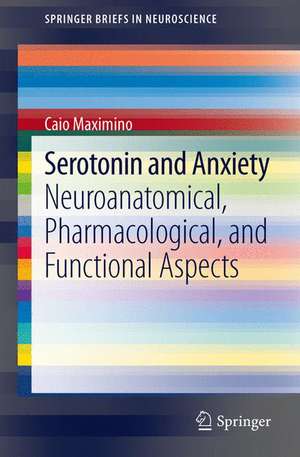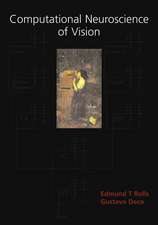Serotonin and Anxiety: Neuroanatomical, Pharmacological, and Functional Aspects: SpringerBriefs in Neuroscience
Autor Caio Maximinoen Limba Engleză Paperback – 31 mai 2012
In this book, the author summarizes the latest findings regarding the role of serotonin in modulating the activity of brain regions which organize behavioral patterns associated with fear, anxiety and stress. The emergent picture is one of far greater complexity than previously thought: while the serotonergic innervation of those brain regions arises from the same structure – the dorsal raphe nucleus – that structure is not homogeneous from anatomical, physiological and neurochemical points of view, nor are its projections to the cerebral aversive and behavioral inhibition systems.
The diverse findings which compose this picture of complexity – whether they arise from developmental neurobiology, electrophysiology, neurochemistry, neuroendocrinology, neuropsychopharmacology or behavioral neuroscience – are integrated in this book. Advanced undergraduate, graduate students, and researchers will benefit from the information. The result sheds light on many important questions regarding the neuroanatomical, pharmacological and functional aspects of the role of serotonin in anxiety disorders, and points to future avenues of research.
Preț: 378.12 lei
Nou
Puncte Express: 567
Preț estimativ în valută:
72.35€ • 75.74$ • 59.87£
72.35€ • 75.74$ • 59.87£
Carte tipărită la comandă
Livrare economică 05-19 aprilie
Preluare comenzi: 021 569.72.76
Specificații
ISBN-13: 9781461440475
ISBN-10: 1461440475
Pagini: 100
Ilustrații: X, 111 p. 7 illus., 5 illus. in color.
Dimensiuni: 155 x 235 x 13 mm
Greutate: 0.18 kg
Ediția:2012
Editura: Springer
Colecția Springer
Seria SpringerBriefs in Neuroscience
Locul publicării:New York, NY, United States
ISBN-10: 1461440475
Pagini: 100
Ilustrații: X, 111 p. 7 illus., 5 illus. in color.
Dimensiuni: 155 x 235 x 13 mm
Greutate: 0.18 kg
Ediția:2012
Editura: Springer
Colecția Springer
Seria SpringerBriefs in Neuroscience
Locul publicării:New York, NY, United States
Public țintă
GraduateCuprins
Introduction and scope of the review.- Anxiety and risk assessment.- Fear/panic and the fight/flight/freeze system.- “Coping” styles, stress reactivity, and the active-passive continuum.- Serotonin in the nervous system of vertebrates.- Synthesis and metabolism of serotonin.- Transport of serotonin: SERT and uptake.- Serotonin receptors.- 5-HT1A receptors.- 5-HT1B receptors.- 5-HT2C receptors.- Nodal structures in anxiety-like and panic-like responses.- Nodal structures regulating anxiety: The behavioral inhibition system.- “Limbic” portions of the medial prefrontal cortex.- The extended amygdala.- The ventral hippocampus.- The lateral habenula.- Nodal structures regulating panic: The cerebral aversive system.- The central amygdala.- The medial hypothalamic defense system.- The mesopontine rostromedial tegmental nucleus.- The periaqueductal gray area.- Locus coeruleus.- The dual role hypothesis.- Destruction or blockade of DRN neurons is anxiolytic and panicogenic.- The defensive context for increased serotonin release.- Topographic organization of DRN. - The dorsal portion of the DRN is part of a mesocorticolimbic system involved in anxiety-like responses.- The caudal portion of the DRN is highly responsive to stress-related peptides.- The lateral wings of the DRN are involved in panic-like responses.- General conclusions.
Recenzii
From the reviews:
“This is a concise, information-packed, to-the-point book on the neurobiology of serotonin in anxiety. … Researchers studying anxiety and the role of serotonin might find this useful. … Each chapter is referenced with relevant and timely citations from the scientific literature.” (Michael Joel Schrift, Doody’s Review Service, November, 2012)
“This is a concise, information-packed, to-the-point book on the neurobiology of serotonin in anxiety. … Researchers studying anxiety and the role of serotonin might find this useful. … Each chapter is referenced with relevant and timely citations from the scientific literature.” (Michael Joel Schrift, Doody’s Review Service, November, 2012)
Textul de pe ultima copertă
Anxiety disorders have long been a research subject for scientists in different areas of inquiry, and the particular role of serotonin – the neurotransmitter which has probably most captured the imagination of laymen and academics alike – is as elusive as the clinical aspects of serotonergic medications. Why are drugs acting at certain serotonin receptors efficacious against generalized anxiety disorder, but not panic disorder? Why is the inverse true for monoamine oxidase inhibitors? These clinically relevant issues are clarified by the neurochemical, anatomical and physiological organization of the serotonergic system.
In this book, the author summarizes the latest findings regarding the role of serotonin in modulating the activity of brain regions which organize behavioral patterns associated with fear, anxiety and stress. The emergent picture is one of far greater complexity than previously thought: while the serotonergic innervation of those brain regions arises from the same structure – the dorsal raphe nucleus – that structure is not homogeneous from anatomical, physiological and neurochemical points of view, nor are its projections to the cerebral aversive and behavioral inhibition systems.
The diverse findings which compose this picture of complexity – whether they arise from developmental neurobiology, electrophysiology, neurochemistry, neuroendocrinology, neuropsychopharmacology or behavioral neuroscience – are integrated in this book. Advanced undergraduate, graduate students, and researchers will benefit from the information. The result sheds light on many important questions regarding the neuroanatomical, pharmacological and functional aspects of the role of serotonin in anxiety disorders, and points to future avenues of research.
In this book, the author summarizes the latest findings regarding the role of serotonin in modulating the activity of brain regions which organize behavioral patterns associated with fear, anxiety and stress. The emergent picture is one of far greater complexity than previously thought: while the serotonergic innervation of those brain regions arises from the same structure – the dorsal raphe nucleus – that structure is not homogeneous from anatomical, physiological and neurochemical points of view, nor are its projections to the cerebral aversive and behavioral inhibition systems.
The diverse findings which compose this picture of complexity – whether they arise from developmental neurobiology, electrophysiology, neurochemistry, neuroendocrinology, neuropsychopharmacology or behavioral neuroscience – are integrated in this book. Advanced undergraduate, graduate students, and researchers will benefit from the information. The result sheds light on many important questions regarding the neuroanatomical, pharmacological and functional aspects of the role of serotonin in anxiety disorders, and points to future avenues of research.
Caracteristici
A unique, integrated approach to the organization of brain structures that play a part in defensive behavior Focuses on animal research Presents interpretations of behavioral, pharmacological, neuroanatomical, and electrophysiological findings? Includes supplementary material: sn.pub/extras





















